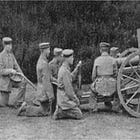Of all of the unit descriptions I have found in the surviving records of the German Army, the oddest by far is a report provided by the 1st Fortress Anti-Tank Company (Festungspakkompanie 1) on 1 October 1944. The first curiosity to strike the eye is the presence of such a report, which describes a painfully sedentary unit, in the papers of the Inspectorate of Armored Troops. The second surprise is the arming of the company with weapons that were poorly suited to the definitive task of the unit. The third feature worthy of note is the fact that, in sharp contrast to nearly all other German Army units for this period, the 1st Fortress Anti-Tank Company was “at establishment,” at least where people and primary weapons were concerned.
The 1st Fortress Anti-Tank Company rated 17 non-commissioned officers, and 54 privates. Of these, 13 non-commissioned officers and 58 privates were on hand on the day of the report. Likewise, it possessed all 12 of the “infantry gun howitzers” it was supposed to have. Indeed, the only shortage in the unit was that of machine guns. According to the report, the company had but 1 of the 12 machine guns it had been authorized.
The 3-inch (7.62mm) infantry gun howitzer with which the fortress anti-tank company was equipped was a Soviet-built “regimental gun” of a model adopted by the Red Army in 1927. Captured in large numbers during the early months of the war between Germany and the Soviet Union, the piece was known in the German Army as Infanterie-Kanonehaubitze 290 (r).
The lineal descendent of the Schneider-Danglis mountain gun (Model 1909) and the Putilov anti-assault cannon (Model 1910), the “infantry gun howitzer” used elements (such as its barrel, breech mechanism, and recoil mechanism) that resembled those of its predecessors. Nonetheless, where the older pieces fired somewhat smaller shells, the Model 1927 used the same projectiles as the full-size 76.2mm field guns of the Red Army, albeit with smaller propellant charges.
Source: Festungspakkompanie 1, Meldung von 1. Oktober 1944, Bundesarchiv/Militärarchiv RH 10/279.
For Further Reading:








The unit was at establishment because it contained men medically unfit for active service, and guns nobody else wanted. Useful only in the Atlantic Wall, where its non-standard ammunition could be stockpiled and was effective against landing craft and infantry on the beaches.